I’ve recently got interested in pinhole photography and have made a couple pinhole cameras (I’ll discuss those in future posts). For the uninitiated, pinhole photography is bare-bones, lensless photography. I like it because it is easy to make your own cameras and develop film/prints at home. If you are interested, I suggest you check out f295.org and its forums.
The biggest challenge of using a pinhole camera is determining the proper exposure. Practically all modern cameras have build in light meters but when your entire camera consists of a Quaker Oatmeal can with a tiny hole in the side, you have no way of measuring light levels except by guessing. Guessing can be accurate if you have lots of experience, which I do not. Luckily, several manufacturers have been making dedicated light meters for decades but unfortunately, they are ridiculously expensive. I figured there had to be a way to make one myself and it turns out, I was right. I will walk you through how to make a light meter from a cheap battery tester and a solar cell ripped from a solar cell from a calculator. You should be able to make one yourself for significantly less than $10. Considering that new light meters can cost hundreds of dollars and even used ones can cost more than $100, I’d say we win!
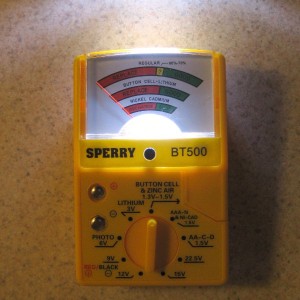
You need a cheap battery tester or multimeter. I bought my battery tester for $6 new. The battery tester is meant to measure 1.5 volts across its range while most analog multimeters I saw measure 5 or 10 volts across their ranges. Since our solar cell will only put out 1 or 2 volts in full light, we will get better resolution if we use the battery tester but the same basic idea could be applied to a multimeter.

The other thing you need is a solar cell. I ripped one out, not quite literally, of a old solar powered calculator whose LCD display had cracked. If need be, you could buy a cheap calculator for $1 and take the solar cell from it.
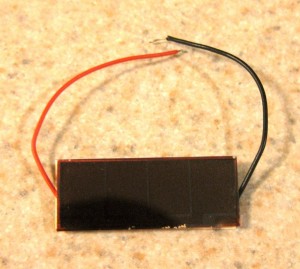
On the back of my battery tester is 1 screw and a warning about the instrument not containing any serviceable parts and you shouldn’t open the unit. This is a load of crap! Firstly, we are going to re-purpose the unit so we don’t really care and secondly, it is a complete lie. If you have a basic understanding of electronics and at least rudimentary soldering skills, you can in fact service this unit. Go ahead and unscrew the 1 screw and take the back off. You should see a simple circuit board with some resistors and a few red and black wires. There are 3 screws on the circuit board that need to be removed before we can lift the circuit board.
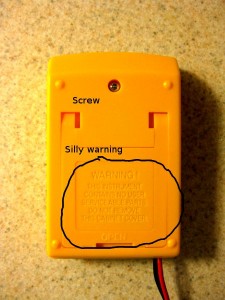
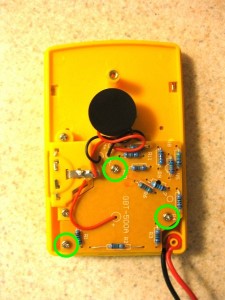
We need to de-solder (preferred) or cut wires free from the circuit board so that we are only left with 1 red and 1 black wire coming from the analog meter, and 1 red and 1 black wire coming from the button that was used to test button cell batteries. There is a red wire connecting the button cell tester to one of the posts used to test 9V batteries. You can remove this wire if you want, but it does not matter. I left it in place. The following photo shows the wires we want to keep.

Next, solder together the black wire from the button cell tester to the red wire from the analog meter. See photo below.
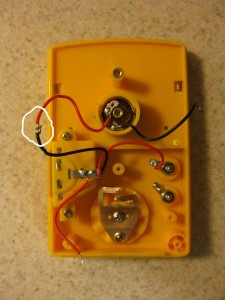
Take the back of the battery tester, the thing with the stupid warning on it, and drill 2 very small holes for the solar cell leads. The solar cell should be glued to the outside of the meter and its 2 wires fed through the holes to the inside. Make the holes as small as possible. I used hot glue although epoxy would make a more permanent bond. The hot glue seems to hold well.
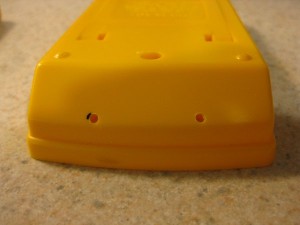
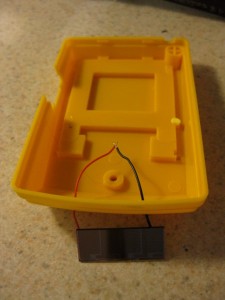
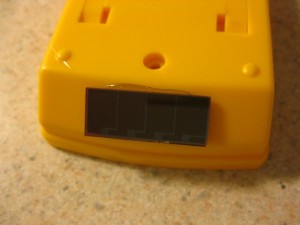
Solder the red wire from the solar cell to the red wire from the button cell tester then solder the black wire from the solar cell to the black wire from the analog meter. Then cover the exposed part of the wires with electrical tape or heat sink tubing to prevent shorts.
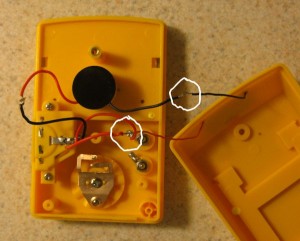
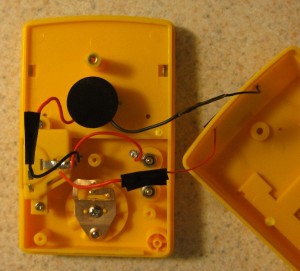
For the final touch we are going to turn the button cell tester into a button that will only let the light meter work when the button cell tester is depressed. This is optional but I think it adds a nice touch and will prevent the analog meter from wearing out when not in use, if that is even possible. There are 2 screws on the button cell tester that need to be removed.
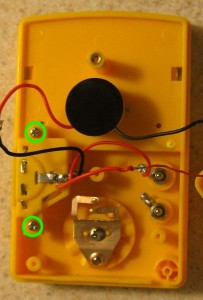
We will solder a small spring to one side of the tester so that the 2 halves will contact each other when the button is depressed but won’t make contact when the button is released. I used a spring from an old clicker pen. These pens are everywhere and they all have little springs that are super useful. Never throw one of these pens away without first stealing the spring! The spring in the pen is way too long for our purposes so you will need to cut it to size with wire cutters or another tool. You want the spring to be just smaller than the gap between the metal plates on either side of the button cell tester.
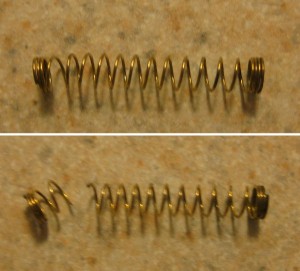
Solder the cut spring to either metal plate of the button cell tester and check to make sure it does not contact both plates when the button is not pressed. Also make sure it does contact both plates when the button is pressed.
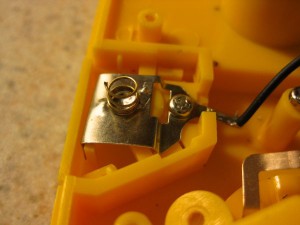
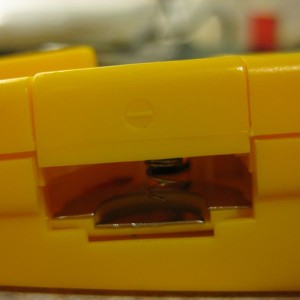
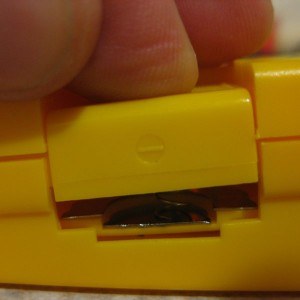
Now screw everything back together and you are done (except for calibration). Test it out by pointing the solar cell at a bright source of light and push down on the button. The needle should move up the scale. How much it moves depends on how bright the light is and the size and efficiency of the solar cell. Hopefully you get good needle deflection in direct sunlight but still some deflection in shade. For my purposes, I just need my meter to work outside in sunny to cloudy conditions and my meter does, in fact, work under these conditions but does not work so well inside but that is OK.

If you want to calibrate the light meter you will need at least temporary access to an actual light meter or a camera with a light meter built in. Point your camera or “real” light meter at an object or scene then point your DIY light meter at the same thing and mark how far the needle moves. If you do this across your meter’s range, you will have a fully functional light meter for under $10.
I you want to make marks directly on the meter’s scale, you will need to remove the clear plastic window above the meter. To do this, you need to remove the sticker directly below the clear plastic to gain access to 2 screws. Unscrew these and pop off the window. Be careful not to mess up the needle while the window is off.
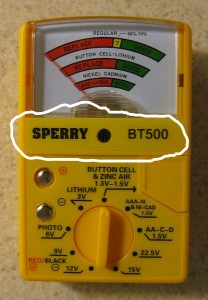

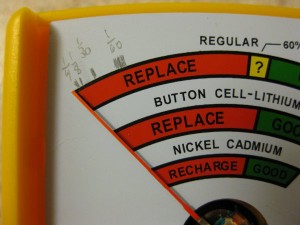
One of these days I will photograph my markings, make a nice graphic scale, print it off on sticker paper, and cover the old scale. Until then, I’m just going to enjoy my cheap, DIY light meter!

Interesting Article.Good effort.I hope the author
will be also interested in applying the principle
to LDR Cell with Battery in stead of Solar Cell.
It will help in better readings indoors.
Yea! Cool scrounging and a real good result. Actually old light meters are available but this is a great little meter no battery! YEA! A cds cell meter is very simple as well if you have a source for cds cells. (cadmium sulfide cell). A photo diode or transistor would be a “better” cell but more detailed oriented this is about unbeatable simplicity and economy with excellent availability of parts! Oh yes! I do personally believe the oats box camera is about the best pin hole rig out there utter simplicity and outstanding amazing wide angle shot. Drop a 8 x 10 inch enlarging paper in a oats box camera put a small rock on top of the camera and activate the shutter mechanism (lol pull the black tape off the front of the pin hole) and walk into the space you have pointed the camera counting for the time (i did “multiple” exposure simply by moving around and siting here and there for the exposure( my pin hole took about 30 sec or so for a photo in sunlight test you exposure is the best way to calibrate as paper hole size and box dimensions can vary!) Amazing fun!
mükemmel
I have noticed you don’t monetize your page, don’t waste your traffic,
you can earn additional cash every month because you’ve got hi quality content.
If you want to know how to make extra money, search for:
Boorfe’s tips best adsense alternative